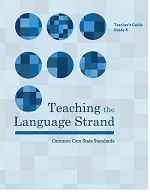Common Core Vocabulary: 12 Program Assessment Questions
Although much of the Common Core State Standards for English Language Arts & Literacy in History/Social Studies, Science, and Technical Subjects affirm what elementary and secondary ELA/reading teachers have always been doing, the breadth, complexity, and depth of instruction in vocabulary may be a noteworthy exception.
The writers of the Common Core State Standards include vocabulary development among a variety of instructional Strands across the curriculum and grade levels. Additionally, the appendices add significant discussion on vocabulary acquisition. Perhaps a brief self-assessment of 12 basic questions may be in order.
Common Core Vocabulary: 12 Program Assessment Questions
- Outside of independent reading, would you say that the bulk of your vocabulary instruction is planned and purposeful or incidental and “as the need arises?”
- Do you teach vocabulary across the curriculum? Using the same strategies?
- How do you teach Tier II and Tier III academic language words? Which words do you teach and how were they determined?
- Do you and your colleagues teach a purposeful scope and sequence of vocabulary instruction across the grade levels?
- Do you teach the connection between vocabulary and spelling/syllabication?
- Do you teach grade level multiple meaning words? How were these words chosen? Which words do your colleagues teach?
- Do you teach specific context clues strategies?
- Do you teach Greek and Latin word parts? Which do you teach? Which do your colleagues teach?
- Do you teach dictionary and thesaurus research skills?
- Do you teach word figures of speech? How were these words chosen? Which words do your colleagues teach?
- Do you teach word relationships? How were these words chosen? Which words do your colleagues teach?
- Do you teach word connotations?
In a nutshell the Common Core Vocabulary Standards do establish the instructional expectations included in the above questions:
The Reading Strand in both Literature and Informational Text includes the same Standard (8.4): Determine the meaning of words and phrases as they are used in a text, including figurative and connotative meanings; analyze the impact of specific word choices on meaning and tone, including analogies or allusions to other texts.
and
The Literacy in History/Social Studies, Science, & Technical Subjects Standards include Vocabulary Standard RST 8.4: Determine the meaning of symbols, key terms, and other domain-specific words and phrases as they are used in a specific scientific or technical context relevant to grades 6–8 texts and topics.
and
The Language Strand devotes three separate Standards: L.4, 5, 6 to vocabulary acquisition.
- Multiple Meaning Words and Context Clues (L.4.a.)
- Greek and Latin Word Parts (L.4.a.)
- Language Resources (L.4.c.d.)
- Figures of Speech (L.5.a.)
- Word Relationships (L.5.b.)
- Connotations (L.5.c.)
- Academic Language Words (L.6.0)
The author of this article, Mark Pennington, has written the assessment-based Grammar, Mechanics, Spelling, and Vocabulary Grades 4-8 programs to teach the Common Core Language Standards. Each full-year program provides 56 interactive grammar, usage, and mechanics lessons. The complete lessons also include sentence diagrams, error analysis, mentor texts, writing applications, and sentence dictation formative assessments with accompanying worksheets (L.1, 2). Plus, each grade-level program has weekly spelling pattern tests and accompanying spelling sort worksheets (L.2), 56 language application opener worksheets (L.3), and 56 vocabulary worksheets with multiple-meaning words, Greek and Latin word parts, figures of speech, word relationships with context clue practice, connotations, and four square academic language practice (L.4, 5, and 6).
